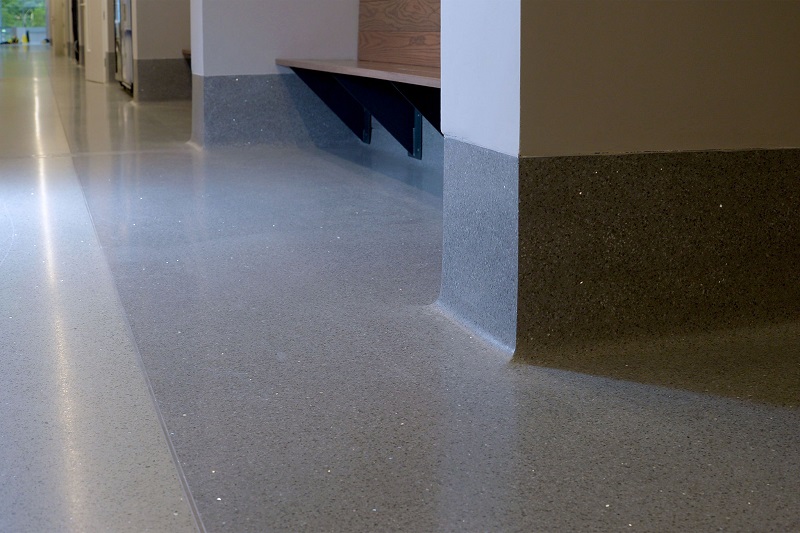Resin flooring
Resin flooring produces a hard-wearing 'plastic' surface. Its highly durable finish means that it is a popular design choice for heavy-use environments such as pharmaceutical, chemical, storage and logistics areas, commercial and public areas.
Typically, resin floors comprise a primer which penetrates and reacts with a substrate layer (usually concrete), creating a high-strength bond. A body coat of resin is then applied on top of the primer, and this creates the bulk of the floor thickness, the decorative finish and key performance characteristics such as impact resistance. Typically, 1-3 seal coats will then be used to encapsulate the body coat and provide additional performance characteristics, such as resistance to chemicals and wear.
The main types of resin used are:
- Epoxy.
- Methyl methacrylate (MMA).
- Polyurethane (PU).
Other ingredients can be added, such as; aggregates, decorative chips/flakes, pigments, cement powder, specific chemical resistance additives and so on. This may increase the thickness of the body coat.
As well as being tougher in compression than concrete, resin flooring can have some stress flexibility, which makes it durable under impact and thermal shock. In addition to its greater compressive strength, resin can dissipate loading and increase the base concrete’s weight-bearing limit.
Other advantages of resin flooring include:
- Ease of maintenance.
- An impervious barrier is created enabling the flooring to be easily cleaned and meaning they don’t harbour bacteria.
- Slip-resistant versions can be created by adding graded aggregates within the base layer, creating safer environments.
- Design flexibility is possible due to a huge range of available finishes.
- There do not need to be joints in the surface layer.
[edit] Related articles on Designing Buildings Wiki
Featured articles and news
RTPI leader to become new CIOB Chief Executive Officer
Dr Victoria Hills MRTPI, FICE to take over after Caroline Gumble’s departure.
Social and affordable housing, a long term plan for delivery
The “Delivering a Decade of Renewal for Social and Affordable Housing” strategy sets out future path.
A change to adoptive architecture
Effects of global weather warming on architectural detailing, material choice and human interaction.
The proposed publicly owned and backed subsidiary of Homes England, to facilitate new homes.
How big is the problem and what can we do to mitigate the effects?
Overheating guidance and tools for building designers
A number of cool guides to help with the heat.
The UK's Modern Industrial Strategy: A 10 year plan
Previous consultation criticism, current key elements and general support with some persisting reservations.
Building Safety Regulator reforms
New roles, new staff and a new fast track service pave the way for a single construction regulator.
Architectural Technologist CPDs and Communications
CIAT CPD… and how you can do it!
Cooling centres and cool spaces
Managing extreme heat in cities by directing the public to places for heat stress relief and water sources.
Winter gardens: A brief history and warm variations
Extending the season with glass in different forms and terms.
Restoring Great Yarmouth's Winter Gardens
Transforming one of the least sustainable constructions imaginable.
Construction Skills Mission Board launch sector drive
Newly formed government and industry collaboration set strategy for recruiting an additional 100,000 construction workers a year.
New Architects Code comes into effect in September 2025
ARB Architects Code of Conduct and Practice available with ongoing consultation regarding guidance.
Welsh Skills Body (Medr) launches ambitious plan
The new skills body brings together funding and regulation of tertiary education and research for the devolved nation.
Paul Gandy FCIOB announced as next CIOB President
Former Tilbury Douglas CEO takes helm.
UK Infrastructure: A 10 Year Strategy. In brief with reactions
With the National Infrastructure and Service Transformation Authority (NISTA).























